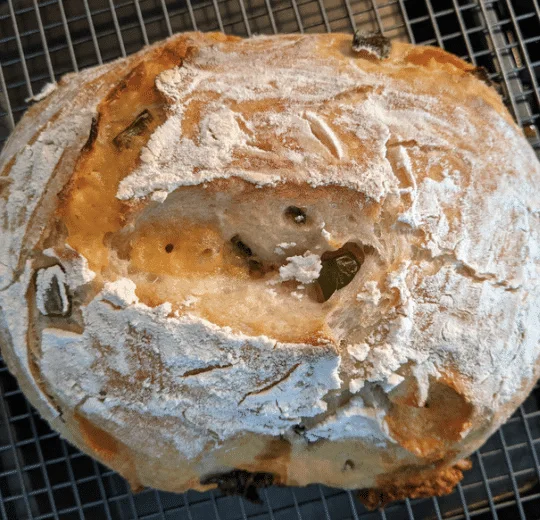Introduction:
Bread, a simple yet universally beloved food, has been a staple of the human diet for thousands of years. The history of bread is a fascinating story that reveals much about the development of human civilization, agriculture, and culinary traditions. In this blog post, we will explore the origins of bread, the evolution of bread-making techniques, and the rich cultural and historical significance of this timeless food.
Ian Alexander, CC BY-SA 4.0 https://creativecommons.org/licenses/by-sa/4.0, via Wikimedia Commons
The Early Beginnings of Bread:
The story of bread begins with the origins of agriculture, as early human societies transitioned from hunter-gatherer lifestyles to settled farming communities. The cultivation of grains, such as wheat and barley, allowed for the development of a more stable food source and the eventual creation of bread.
Archaeological evidence suggests that the first bread-like products were made more than 30,000 years ago, long before the advent of agriculture. Early humans would grind grains and seeds into a coarse flour, which was then mixed with water and cooked on hot stones or in the ashes of a fire. These early breads were likely quite dense and hard, but they provided essential sustenance and energy for our ancestors.
As agriculture developed and grain production increased, so too did the techniques for bread-making. By around 10,000 BCE, humans in the Fertile Crescent began to cultivate wild varieties of wheat and barley, leading to the domestication of these staple grains. The surplus of grain allowed for the development of more advanced bread-making techniques, including the use of leavening agents like yeast.
The Rise of Leavened Bread:
The invention of leavened bread, or bread made with yeast or other fermenting agents, marked a significant turning point in the history of bread. Leavened breads are lighter and more palatable than their unleavened counterparts, and they quickly gained popularity in ancient societies.
The ancient Egyptians are often credited with the invention of leavened bread around 4000 BCE. They discovered that wild yeasts present in the environment could be harnessed to ferment dough, causing it to rise and become lighter in texture. This was a groundbreaking development in the world of bread-making and laid the foundation for the diverse array of breads we enjoy today.
Bread in Ancient Civilizations:
Throughout history, bread has played a central role in the diets and cultures of numerous ancient civilizations. Here, we will explore the significance of bread in a few notable examples:
- Egypt: As mentioned earlier, the ancient Egyptians were pioneers in the world of leavened bread. Bread was a dietary staple in ancient Egypt, and it was often used as a form of currency or payment for laborers. There were many different types of bread in ancient Egypt, ranging from simple flatbreads to more elaborate, sweetened varieties. The process of bread-making was considered a sacred art, and bread held deep symbolic significance in Egyptian culture.
- Greece: Bread was also a central component of the ancient Greek diet, and it was often served with olive oil, cheese, or other accompaniments. The Greeks developed numerous types of bread, including barley loaves and wheat breads flavored with honey or herbs. In ancient Greece, bread was often used as an offering to the gods, reflecting its importance in daily life and religious rituals.
- Rome: The Romans were known for their love of bread, and they developed a vast array of bread recipes and techniques. Roman bakers used a variety of grains, including wheat, barley, and millet, and they often incorporated ingredients like cheese, honey, and spices into their breads. The Roman Empire’s extensive network of roads and trade routes allowed for the spread of bread-making techniques and recipes throughout the Mediterranean region, influencing the culinary traditions of countless cultures and societies.
- Mesopotamia: Bread was a crucial part of daily life in ancient Mesopotamia, where the cultivation of grains like barley and wheat was essential to sustaining their growing populations. Mesopotamians developed a variety of bread types, including both leavened and unleavened varieties. Bread was not only a dietary staple but also held spiritual significance, as it was often used as an offering to the gods.
(Picture of flour here)
The Middle Ages and Bread-Making Innovations:
As the world entered the Middle Ages, bread-making continued to evolve and diversify. New techniques and technologies, such as the introduction of water mills for grinding grain, led to the creation of finer flours and more refined breads. The increased availability of wheat flour during this period resulted in the development of lighter, whiter breads that were considered more desirable than the darker, coarser breads made from barley or rye.
The social stratification of the time was often reflected in the types of bread consumed, with the upper classes enjoying the more refined, white breads, while the lower classes were relegated to the darker, heavier breads. Bread also served as an important source of nutrition during times of scarcity, as it could be stored for extended periods and provided much-needed sustenance.
The Global Spread of Bread:
As trade and exploration expanded during the Age of Discovery, the art of bread-making spread across the globe. European colonists and explorers introduced bread to the Americas, Asia, and Africa, where it quickly became a staple food in many regions.
Each new destination adapted bread-making techniques and recipes to suit local ingredients and tastes. For example, in the Americas, corn and maize became popular grain choices for bread-making, while in India, breads like naan and roti emerged as integral components of the local cuisine.
(wonder bread loaves here)
The Industrial Revolution and Bread Production:
The Industrial Revolution had a profound impact on the production and consumption of bread. The invention of steam-powered mills allowed for the mass production of flour, making bread more affordable and accessible than ever before. The development of commercial yeast and the introduction of the mechanical dough mixer further streamlined the bread-making process, leading to the creation of factory-produced bread.
While these innovations made bread more readily available, they also resulted in a decline in the quality and nutritional value of mass-produced bread. In response to this, the late 19th and early 20th centuries saw a resurgence of interest in traditional bread-making techniques and artisanal breads, as people sought out higher-quality, more nutritious options.

Modern Bread and Beyond:
Today, bread remains a beloved and essential food around the world. Modern technology has made it possible to produce an incredible variety of breads, ranging from classic sourdough loaves to gluten-free options made from alternative grains.
The recent popularity of artisanal bread-making and the increasing awareness of the importance of whole grains and high-quality ingredients have led to a renewed appreciation for the craft of bread-making. Home bakers and professional bread makers alike continue to experiment with new techniques, recipes, and flavors, ensuring that the future of bread is as diverse and delicious as its storied past.
Conclusion:
The history of bread is a fascinating tale of human ingenuity, culinary innovation, and cultural exchange. From its humble beginnings as a simple, unleavened flatbread to the diverse array of breads enjoyed around the world today, bread has remained a central and enduring part of the human experience.
As we continue to explore new culinary frontiers and celebrate the rich traditions of the past, there is no doubt that bread will continue to nourish and inspire us for generations to come. So the next time you savor a warm, crusty loaf or a soft, pillowy slice, take a moment to appreciate the long and storied history.

